Partners reviewed the latest EU developments and discussed on key elements to be considered in the 2021-2027 EU Cohesion Funds programmes to ensure they effectively consider Roma population.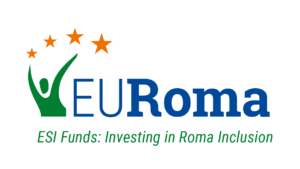
EURoma Network held its latest Management Committee meeting on 29-30 June 2021. As previous meeting, it was held online to adapt to the current circumstances. The meeting brought together over 80 participants, including representatives of Network partner organisations (public bodies responsible for European Structural and Investment Funds and those in charge of Roma policies, notably National Roma Contact Points, NRCPs) from sixteen EU Member States and representatives of the Network Technical Secretariat (Fundación Secretariado Gitano). It also counted on the participation of European Commission’s Directorate-Generals (DGs) with competences in Roma inclusion, the European Social Fund (ESF) (European Social Fund Plus (ESF+) in future) and the European Regional Development Fund (ERDF), notably DG Justice and Consumers (DG JUST), DG Regional and Urban Policy (DG REGIO) and DG Employment, Social Affairs and Inclusion (DG EMPL).
Much progress has been made since the first online EURoma Network Management Committee (October 2020) as regards the definition of the policy and financial frameworks related to Roma equality and inclusion. On the one hand, following the adoption of the EU Roma Strategic Framework, including the European Commission Communication and the Council Recommendation on Roma equality, inclusion and participation, Member States are finalising their Roma National Strategic Policy Frameworks (NSPFs) (expected for September 2021). On the other, in parallel to the entry into force of the Cohesion Policy Funds Regulations on 1 July, countries are progressing on the programming of their ESF+/ERDF programmes and on their plans to use the funds available through the Recovery and Resilience Facility. Finally, different EU initiatives of direct relevance for Roma equality and inclusion have been adopted (e.g., European Anti-Racism Action Plan, European Child Guarantee…).
In this context, EURoma Management Committee pursued two main objectives:
- To review recent EU developments of relevance for Roma equality and inclusion, with particular attention to the opportunities offered and the connection between the policy and financial frameworks;
- To promote the effective inclusion of Roma in the programming of the 2021-2027 EU Cohesion Funds programmes. To this end, the meeting focused on a number of aspects that it would be essential to consider in the programming documents: firstly, the connection between the Roma NSPFs and the European Policy Cohesion Funds; secondly, the use of a dual/combined approach (target & mainstream) within existing policy and financial instruments (at national and regional level) to address Roma equality and inclusion.
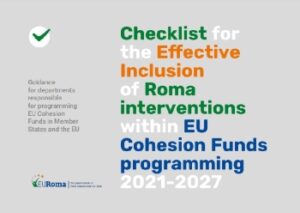 EURoma´s Checklist for the effective inclusion of Roma interventions within EU Cohesion Funds programming 2021-2027 served as reference for the discussions on both topics. This document aims to offer guidance to EU, national and regional departments responsible for programming EU Cohesion Funds (especially ESF+ and ERDF) on how to set the adequate basis in the programming documents, mainly the Partnership Agreement and the EU Cohesion Funds programmes, to ensure that measures implemented in the future have a real impact and contribute to reducing Roma exclusion and discrimination effectively.
EURoma´s Checklist for the effective inclusion of Roma interventions within EU Cohesion Funds programming 2021-2027 served as reference for the discussions on both topics. This document aims to offer guidance to EU, national and regional departments responsible for programming EU Cohesion Funds (especially ESF+ and ERDF) on how to set the adequate basis in the programming documents, mainly the Partnership Agreement and the EU Cohesion Funds programmes, to ensure that measures implemented in the future have a real impact and contribute to reducing Roma exclusion and discrimination effectively.
Welcome and opening remarks by host country representatives
Representatives of the Spanish Network partners (ESF Managing Authority and NRCP) and of the European Commission’s DG EMPL and DG JUST were in charge of welcoming participants and sharing with them some initial ideas about the current state-of-play as regards the policy framework for Roma inclusion and the available EU funding to support it as well as the potential role of EURoma Network and partner organisations.
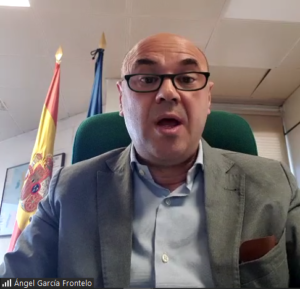 Ángel Mª García-Frontelo, Deputy General Director of Spanish ESF Managing Unit stressed that the next months will be crucial as Member States will be deciding, along with the European Commission, where ESF+ and ERDF funds will be allocated. Therefore, it is the time to work together and make the most of EU funding for Roma inclusion.
Ángel Mª García-Frontelo, Deputy General Director of Spanish ESF Managing Unit stressed that the next months will be crucial as Member States will be deciding, along with the European Commission, where ESF+ and ERDF funds will be allocated. Therefore, it is the time to work together and make the most of EU funding for Roma inclusion.
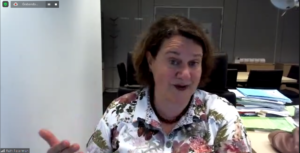 Ruth Paserman, Director for Investment of European Commission DG EMPL, added that it is neccessary that Cohesion Policy Funds are programmed together with the funds available through the Recovery and Resiliency Facility (RRF) in order to promote complementarities and synergies and avoid overlaps and gaps.
Ruth Paserman, Director for Investment of European Commission DG EMPL, added that it is neccessary that Cohesion Policy Funds are programmed together with the funds available through the Recovery and Resiliency Facility (RRF) in order to promote complementarities and synergies and avoid overlaps and gaps.
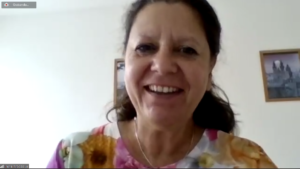 And, as stated by Irena Moozova, Director for Equality and Union Citizenship of DG JUST, the current context of development of the Roma NSPFs and the European financial instruments offers an excellent opportunity to match our current vision and ambition with investments.
And, as stated by Irena Moozova, Director for Equality and Union Citizenship of DG JUST, the current context of development of the Roma NSPFs and the European financial instruments offers an excellent opportunity to match our current vision and ambition with investments.
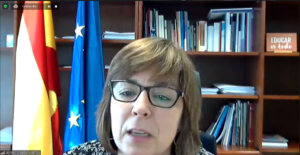 Patricia Bezunartea, Director General of Family Diversity and Social Services at the Spanish Ministry of Social Rights and 2030 Agenda, concluded by recalling the role that EURoma has always played in this sense as a priviledge platform to bring together authorities in charge of Roma policies and of EU funds. She also reminded the importance to promote elements such as the dual approach, the long-term and the large scale to achieve a real impact.
Patricia Bezunartea, Director General of Family Diversity and Social Services at the Spanish Ministry of Social Rights and 2030 Agenda, concluded by recalling the role that EURoma has always played in this sense as a priviledge platform to bring together authorities in charge of Roma policies and of EU funds. She also reminded the importance to promote elements such as the dual approach, the long-term and the large scale to achieve a real impact.
They all highlighted the importance of promoting parternship and cooperation among all actors (NRCP, Managing Authorities, civil society organisations, local and regional authorities…) in order to achieve success. According to them, without cooperation we cannot achieve the real progress and fulfil the targets and objectives by 2030.
Review of relevant EU developments regarding ESI Funds and Roma inclusion
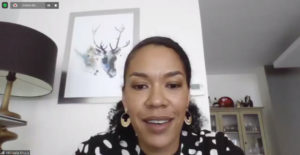 Michaela Moua, appointed as the first-ever European Coordinator on Anti-Racism only a few weeks before the meeting presented the Anti-Racism Action Plan and its implications for Roma equality and inclusion with a view to finding synergies. According to Ms. Moua, we count on an ambitious action plan, including comprehensive, horizontal and intersectional measures, to step up the fight against discrimination.
Michaela Moua, appointed as the first-ever European Coordinator on Anti-Racism only a few weeks before the meeting presented the Anti-Racism Action Plan and its implications for Roma equality and inclusion with a view to finding synergies. According to Ms. Moua, we count on an ambitious action plan, including comprehensive, horizontal and intersectional measures, to step up the fight against discrimination.
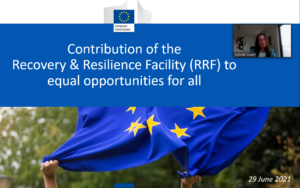 Kathrin Jewert, of the European Commission Recovery and Resilience Task Force, provided an overview of the main characteristics of the Recovery and Resilience Facility, with a focus on equal opportunities for all. This is an unprecedented opportunity to speed up the recovery but also to reinforce the green and digital transitions while making sure that no one is left behind and that the recovery is inclusive.
Kathrin Jewert, of the European Commission Recovery and Resilience Task Force, provided an overview of the main characteristics of the Recovery and Resilience Facility, with a focus on equal opportunities for all. This is an unprecedented opportunity to speed up the recovery but also to reinforce the green and digital transitions while making sure that no one is left behind and that the recovery is inclusive.
 Irma Borde, of DG EMPL, shared information about the European Child Guarantee and its potential to prevent and combat child poverty and social exclusion and to foster equal opportunities for Roma children, identified as one of the target groups of the initiative. She also refered to ESF+ and ERDF as key EU funding sources for the implementation of the Guarantee.
Irma Borde, of DG EMPL, shared information about the European Child Guarantee and its potential to prevent and combat child poverty and social exclusion and to foster equal opportunities for Roma children, identified as one of the target groups of the initiative. She also refered to ESF+ and ERDF as key EU funding sources for the implementation of the Guarantee.
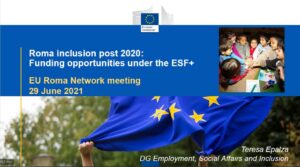 Otilia Ciobanu of DG REGIO and Teresa Epalza of DG EMPL presented the key elements for Roma equality and inclusion in the Common Provisions Regulations (CPR), the European Regional Development Funds (ERDF) and the European Social Fund (ESF+) Regulations.
Otilia Ciobanu of DG REGIO and Teresa Epalza of DG EMPL presented the key elements for Roma equality and inclusion in the Common Provisions Regulations (CPR), the European Regional Development Funds (ERDF) and the European Social Fund (ESF+) Regulations.
Hristina Petkova, of DG JUST, then refered to the Council Recommendation on Roma equality, inclusion and participation.
Synergies and coordination between the National Roma Policy Framework and EU Funds
It is widely agreed that, while other factors are important for an efficient use of ESI Funds (e.g. long-term approach, combination of target/mainstream approaches…), the alignment and coordination between Roma policies and EU Funds is essential to increase the efficiency and impact of these funds for Roma inclusion. However, despite the wide recognition of its importance, the positive current framework (EU Roma Framework and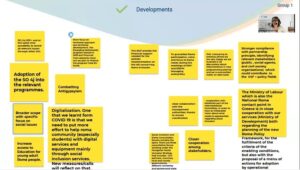 EU Funds clearly link these two areas) and the progress made over the last years, coordination is still one of the most challenging areas.
EU Funds clearly link these two areas) and the progress made over the last years, coordination is still one of the most challenging areas.
Against this background, partners reflected on the main developments compared to the 2014-2020 programming period and the main challenges (and possible solutions to overcome them).
Thematic session: Achieving a dual/combined approach included in EU instruments for Roma inclusion and equality
Reflecting during the programming of the EU Cohesion Policy Funds on the approach(es) to be used to address Roma equality, inclusion and participation and on how they are conceived is crucial as they will determine how the funds are used throughout the whole 2021-2027 period.
Experience shows the need for targeted actions when there are big inequalities between Roma and non-Roma and for mainstream actions when universal services are insufficiently inclusive with Roma or do not reach them. In addition, the combination of both approaches, as promoted by the current political and financial frameworks, seems to be the most effective option.
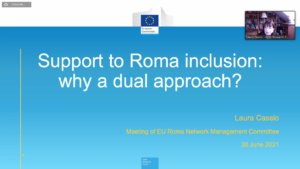 Laura Cassio of the European Commission Joint Research Centre (JRC) started with a general reflection, from an academic point of view, on why combining mainstream and target measures, building on the premise that ‘both are necessary, but neither is sufficient’.
Laura Cassio of the European Commission Joint Research Centre (JRC) started with a general reflection, from an academic point of view, on why combining mainstream and target measures, building on the premise that ‘both are necessary, but neither is sufficient’.
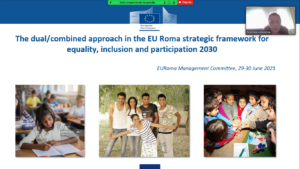
Representatives from European Commission Directorate-Generals Justice (Marcela Adamova), Employment, Social Affairs and Inclusion (Teresa Epalza) and Regional Policy (Otilia Ciobanu) then provided further ideas for the 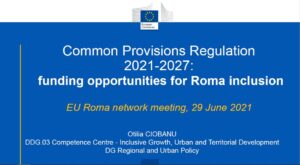 reflection by sharing how the dual/combined approach is conceived in the 2020-2030 EU Roma Strategic Framework for equality, inclusion and participation as well as in the 2021-2027 Cohesion Policy Framework.
reflection by sharing how the dual/combined approach is conceived in the 2020-2030 EU Roma Strategic Framework for equality, inclusion and participation as well as in the 2021-2027 Cohesion Policy Framework.
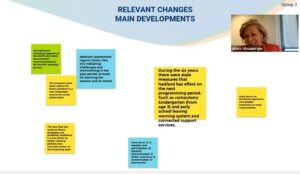 Participants then reflected on the use of the different approaches based on their experiences and views. They particularly focused on main developments/relevant changes in relation to the 2014-2020 programming period and the reasons behind the selection of the different approaches, including the benefits and challenges of them and safeguards and adaptations to be taken into account.
Participants then reflected on the use of the different approaches based on their experiences and views. They particularly focused on main developments/relevant changes in relation to the 2014-2020 programming period and the reasons behind the selection of the different approaches, including the benefits and challenges of them and safeguards and adaptations to be taken into account.

